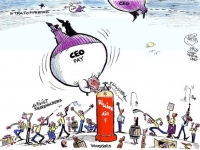Soaring Executive Pay Attacked by Shareholder Activists

Peter Rose, a Seattle-based corporate chief executive offficer, took home $4.7
million last year. He thinks that's quite enough.
"There's only so much crap you can buy," he told his hometown newspaper.
His colleagues in corporate America seem not to agree.
Last year, the CEOs of the 500 biggest U.S. companies averaged $15.2 million in total annual compensation, according to Forbes business magazine's annual executive pay survey. The top eight CEOs on the Forbes list each pocketed over $100 million.
Larry Ellison, CEO of business software giant Oracle, was not in the top eight. But
as the 11th richest man in the world, who ended last year worth more than $16 billion, he is not doing badly.
University of Chicago economist Austan Goolsbee points out that a CEO like Ellison literally cannot spend enough on personal consumption to stop his fortune from growing. Goolsbee calculates that Ellison would have to spend over "$183,000 an hour on things that can't be resold, like parties or meals, just to avoid increasing his wealth."
Stunning numbers like these have moved executive pay onto America's political radar screen. In a "state of the economy" address earlier this year, even President George W. Bush took note.
"America's corporate boardrooms must step up to their responsibilities," the President proclaimed to a business audience. "You need to pay attention to the executive compensation packages that you approve."
At corporate annual shareholder meetings held across the U.S., activist individual and institutional investors have tried to encourage the process. They introduced resolutions designed to curb executive pay excess and, at one annual meeting after another, directly challenged presiding CEOs.
In May, at the annual meeting of the Denver-based telecom Qwest, high school teacher Linda Baggus - annual salary: $55,000 - wanted to know how CEO Dick Notebaert could justify his annual earnings, estimated at $33 million by one Midwest daily newspaper.
"How is the service that you render so much more valuable than the service I render?" she asked.
Notebaert gave the standard corporate defense for American CEO pay levels.
Life at the Top: Consuming Interest How do CEOs spend their paychecks? In a way, just like everyone else, except more so. Quite a bit more so. Take housing, the largest single expenditure households make. Dwight Schar, the CEO of construction industry giant NVR, shelled out $70 million three years ago for his new home in Florida's Palm Beach. His beachfront manse features 18 bathrooms, a movie theater, and a walk-in humidor for cigars. The most expensive private home sold in the United States last year went to Richard Kurtz, the CEO of Advanced Photonix, a telecom supplier, for $58 million. |
His pay, he explained, depends on his "performance" and reflects the realities of a "very competitive market" for executive talent.
His defense carried the day. Four shareholder resolutions designed to clamp down on CEO pay excess failed to win majorities at the Qwest meeting.
In early June, activists figured they would do better at the annual meeting of Yahoo, the global Internet giant headquartered in California's Silicon Valley. The situation appeared to offer reformers all they needed: a CEO at the top of the pay charts; lackluster corporate performance; many angry shareholders.
In 2006, Yahoo shares had sunk 35 percent, or about $20 billion, in value. Top talent, according to press reports, was jumping ship. A leaked internal Yahoo memo -- known in tech sector circles as the "Peanut Butter Manifesto" - said that, like peanut butter on toast, Yahoo management was spreading the company dangerously thin.
Thinner, certainly, than the bulging wallet of CEO Terry Semel. Last year Semel pocketed $71.7 million, over twice the take-home of any other chief executive in Silicon Valley. Since 2001, the year he left Hollywood to take Yahoo's top slot, Semel has cashed out an additional $450 million in personal stock option profits.
By early June, three major shareholder advisory companies - which advise large investors how to vote at corporate annual meetings - had had enough. They urged a "no" vote on the re-election of three Yahoo board members who had served on the company's executive pay committee.
One of the three companies, Proxy Governance Inc., noted that Semel's compensation was running 926 percent "above the median paid to CEOs at peer companies."
Semel walked into Yahoo's June 12 annual meeting prepared to counterattack. "Yahoo has staked out a strong competitive position and we are better positioned than we have ever been before," he pronounced.
Activist shareholders disagreed. "I am surprised you did not apologize to Yahoo shareholders for the last three years of performance," said one, Florida money manager Eric Jackson.
There were no apologies. Instead, Semel and his management team prevailed in every executive pay-related vote they faced. Only a third of the Yahoo shareholder vote opposed the re-election of the targeted board members.
Performance: Games Executives Play |
A resolution seeking to tie Yahoo executive pay to a more competitive performance standard lost by the same two-to-one margin.
A crushing setback for shareholder activism? Not exactly. The week after the annual meeting, the Yahoo corporate board announced Semel's resignation.
Had shareholder activists triumphed over executive pay excess? Well, Semel may be out, but CEO pay remains on the rise. If Yahoo's next CEO takes home the same half-billion over six years as Semel, will Americans concerned about executive pay have reason to cheer?
Margaret Covert doesn't think so. Covert coordinates shareholder activism for NorthStar Asset Management, a Boston-based wealth management company. "It comes down to having a company share its bounty with all its workers," she told CorpWatch. "All workers have contributed to company success. They should all share in the rewards, not just the top tier."
NorthStar asked shareholders of ExxonMobil, the world's most profitable corporation, to call on the company to prepare a study that compares the "total compensation package of our CEO and our company's lowest paid U.S. workers in September 1995 and September 2005.
"As shareholders," the proposed NorthStar resolution read, "we are concerned that the over-compensation of top executives has a negative effect on employee morale and customer trust."
NorthStar president Julie Goodridge carried the resolution to the May 30 ExxonMobil annual meeting at the Morton H. Meyerson Symphony Center in Dallas, reminding the thousand or so shareholders present that CEO Rex Tillerson took home just over $22 million in 2006.
"Our resolution asks shareholders to join us in questioning why it takes our lowest-paid employees a full year to earn what Mr. Tillerson earns for an hour on the job," Goodridge said, "... because we believe it is fiscally irresponsible for a company to put so much of its resources into a single individual.
"High company profits do not justify outrageous CEO compensation."
No shareholders spoke in favor of Goodridge's resolution. She claims ExxonMobil officials structured the annual meeting so that they could not do so.
"At ExxonMobil's meeting last year, people could get up and make statements on behalf of resolutions they supported," she explains. "The mikes were set up in the audience, and you could just line up at a mike and have your say." This year, she says, Exxon allowed only the sponsors of a resolution to make a statement: "It felt like a much more hostile meeting than last year."
The NorthStar resolution gained just under 12 percent of the shareholder vote.
A resolution in a similar vein also made little headway at the annual meeting of retail giant Wal-Mart. The resolution asked why the company's top five officers, who make up 0.000003 percent of the company's workforce, were pulling in 18.2 percent of the total stock options Wal-Mart granted each year.
"If options are a good incentive to get people to do a good job," says Mike Lapham, director of Responsible Wealth, a national group that links affluent individuals from across the U.S. and which introduced the resolution, "why not use them for employees on the store floor, too, and help the women and people of color who work at Wal-Mart build their assets?"
The environment at the annual meeting didn't encourage serious debate on such a deep question. Lapham describes the meeting as more like a pep rally than a business gathering, with 15,000 of Wal-Mart's most enthusiastic employees - "associates," to use the official company term - packed into the University of Arkansas basketball arena for a four-hour entertainment extravaganza that featured the comedian Sinbad.
"The shareholders resolutions come up when the employees take a bathroom break," says Lapham.
Top Wal-Mart officials never came forward to debate the Responsible Wealth resolution - or any of the other three resolutions that sought to challenge the company's executive pay practices.
They left their defense of pay arrangements to the explanations of corporate policy in the official annual meeting documents.
"Our associates respect that Wal-Mart has a well-recognized culture of opportunity," the documents stated. "They are proud that their CEO started as a manager in the trucking division and has stayed with the company for 28 years."
The Responsible Wealth resolution collected about the same support as the NorthStar initiative at ExxonMobil. However, executive pay resolutions at other corporate annual meetings in recent months have fared better.
U.S. trade unions pushed particularly hard this spring for "say on pay" resolutions designed to give shareholders the right to take annual advisory votes on executive pay packages. This right is now enshrined in law in Australia, Sweden and the UK. In the Netherlands and Norway, shareholders have the right to take a binding executive pay vote.
CEO Pay: Defense is the Best Form of Attack |
Last year only a half-dozen advisory "say on pay" resolutions were tabled at annual meetings. This year, "say on pay" debates have erupted at nearly ten times that number of annual meetings, and most have attracted 40 percent or more of shareholder votes. Four even won majorities - at Blockbuster, Ingersoll-Rand, Motorola and Verizon.
Shareholder activists hail the results as significant.
Until recently, explains veteran shareholder organizer Tim Smith, only church groups and labor and public employee pension funds seemed willing to challenge management on executive pay. That's changed, says Smith, a senior vice president at Walden Investment Management and chair of the Social Investment Forum, the top U.S. trade association for social investors: "You don't get 35 percent of a shareholder vote without some big institutional investors saying no."
Major institutional investors, such as the T. Rowe Price mutual fund family, are now eager to give shareholders "the tools they need to hold corporate boards of directors accountable," adds Dan Pedrotty, director of the AFL-CIO's office of investment, the coordinating center of American labor's shareholder activism.
"We're becoming more of a critical mass," agrees NorthStar Asset's Julie Goodridge. "It's one thing when an investor with a few thousand shares objects - quite another when an investor with millions of shares stands up."
In Plano, Texas, some of those investors stood up at the May 18 annual meeting of retail giant J. C. Penney, which last year handed $10.2 million in severance pay to an executive who had spent only six months in the job.
Shareholders passed a resolution, sponsored by the Bricklayers Union, asking company management to secure shareholder approval in advance for any future severance package that exceeds an executive's regular annual salary and bonus by 2.99 times or more.
The J. C. Penney corporate board is not obliged to implement the resolution, because shareholder resolutions at U.S. annual meetings typically function only as
recommendations.
Reformers acknowledge that corporate boards already ignore public frustration over rising executive paychecks. "We're disappointed to see packages continuing to spiral upward," Service Employees Union corporate activist Tracey Rembert told CorpWatch. "The lump sum numbers now public under the new SEC disclosure rules have been shocking."
Last summer the SEC (the federal Securities and Exchange Commission) promulgated regulations requiring publicly traded companies in the U.S. to reveal previously largely hidden categories of executive compensation.
Among the surprises the new SEC regulations have helped bring to light: the $415.5 million in 2006 take-home for Occidental Petroleum CEO Ray Irani. He pocketed $52.1 million in salary, bonus, perks and stock awards and cleared another $270.1 million cashing out stock options awarded in previous years. And he withdrew another $93.3 million from his Occidental "deferred pay" account.
Some observers had predicted that the SEC regulations would help curb executive
compensation increases. Certainly, shareholders have more information than ever before. Nevertheless, executives and corporate boards still enjoy a huge advantage in the ongoing debate because both they and the critics share an assumption that executives who perform well deserve to be rewarded.
"Pay should be linked to performance, that's the common denominator," says Walden Investment Management's Tim Smith. "Nothing will raise investor ire more than if pay does not seem to be linked to performance."
Executives have learned how to spin performance statistics to deflect attacks.
Angelo Mozilo, for instance, has collected over $285 million in the last 11 years as
CEO of Countrywide Financial, the largest U.S. home mortgage lender. At
Countrywide's annual meeting in May, Mozilo presented a list showing that
Countrywide was 12th in a list of U.S. companies that had generated the greatest
returns for shareholders. That placed it ahead of corporate giants Dell and Berkshire Hathaway whose top guns, Michael Dell and Warren Buffett, he noted, had both become "multibillionaires."
Mozilo's not-so-subtle message to shareholders: At $285 million, I'm a bargain.
Executives usually have little difficulty finding some "metric" that proves they have performed well and richly deserve generous rewards. Corporate board executive compensation committees make metric cherry-picking easy. They will often cite, Tim Smith notes, a long list of metrics that guide their determination of performance, but leave unclear which performance measurements matter most.
In this spring's round of corporate annual meetings, the Carpenters Union led an effort to clamp down on performance metric gamesmanship. The Carpenters and allied groups pushed a resolution asking corporate boards to benchmark their performance standards against competing firms. The goal: no windfalls for executives whose companies fail to beat their competitors.
The approach proved a hard sell. The failure of every "pay for superior performance" resolution to gain a majority in shareholder voting has become a basic fact of life for corporate activists. So what keeps these activists coming back to shareholder meetings, year after year, when they usually have so little to show for their efforts?
Scott Klinger, research director of Corporate Accountability International and a veteran of the annual meeting scene since the mid-1980s, emphasizes that annual shareholder meetings play a unique role. Every other day of the year, Klinger says, CEOs live in their own separate universe.
"Corporations now require their top executives to fly on corporate aircraft for security reasons," he explains. "They never even get to meet first-class passengers. They come to believe they're special. They never see real life."
Activists like Responsible Wealth's Mike Lapham are working to bring that real life into annual meetings. Earlier this year, deep-pocketed members of Responsible Wealth joined TIGRA (the Transnational Institute for Grassroots Research and Action) in a campaign to press Western Union to lower the fees the company charges immigrants to send remittances home.
Activists at the Western Union annual meeting accompanied immigrants with troubling stories to tell about how remittance fees were squeezing their families. Lapham says Western Union executives came face-to-face with people they would never otherwise encounter.
"Moments like that," he observes, "are one of the rare times executives ever get to hear the downside of how they're making their money."
Activists at this spring's corporate annual meetings weren't able to accomplish anything that will immediately staunch the flow of money into executive pockets. But they will return next year. The tide, most seem convinced, may be turning - and now's no time to turn back.
*Sam Pizzigati, an associate fellow at the Institute for Policy Studies in Washington, D.C., edits Too Much, an online newsletter on excess and inequality. His "Greed and Good: Understanding and Overcoming the Inequality that Limits Our Lives" - an American Library Association award-winning book now available for online reading - critically examines the rationales for current executive pay practices.
- 186 Financial Services, Insurance and Banking



